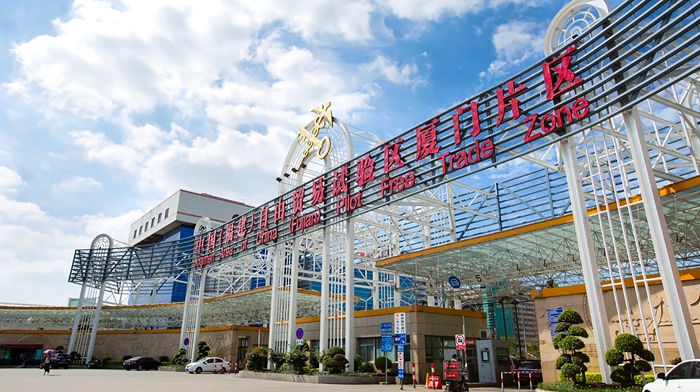
Xiamen Area of China (Fujian) Pilot Free Trade Zone [Photo provided to ftz.xm.gov.cn]
With its total area of 43.78 square kilometers, the Xiamen Area of China (Fujian) Pilot Free Trade Zone – or Xiamen Free Trade Zone, or XMFTZ for short – is located in the port city of the same name in East China's Fujian province.
Ever since it was launched – on April 21, 2015 – it has been working hard to promote high-level opening up.
Acting on the decisions and policies of the Communist Party of China Central Committee and the State Council – as well as those of the CPC Fujian Provincial Committee and the Fujian government – the area has issued an array of innovative initiatives that have boosted the high-quality development of the FTZ. Over the past seven years, the added value of major industries there has increased by 14.77 percent on a year-on-year basis, while the total volume of imports and exports has increased by 20.23 percent annually and yearly fiscal revenue has increased by 13.87 percent.
First: Promoting institutional innovation
Since the area was launched, it has unveiled 521 innovative initiatives. According to the results of a third-party review carried out by the province's free trade office, 126 of them were proposed for the first time nationwide and 30 have been promoted across the country. As well, five typical cases were selected to be on the list of the "Best Practice Cases" in national pilot free trade zones and 69 policies were approved by ministries and commissions under the State Council, or China's Cabinet.
Second: developing a world-class business environment
The area has implemented a policy – called the "pre-establishment national treatment plus negative list plus filing management" – to attract foreign investment. It has deepened reforms of its commercial system and administrative approvals system – and actively explored new ways to protect intellectual property rights. Moreover, it has taken the lead across the country in formulating measures to reduce costs and increase efficiency at ports and established a transparent and efficient legal system to guarantee foreign investment. In the "2020-2021 China Pilot Free Trade Zone Institutional Innovation Index," released by the Free Trade Zone Comprehensive Research Institute at Sun Yat-sen University – located in the city of Guangzhou in South China's Guangdong province – it ranked in the top five of the free trade zones in China.
Third: serving the national strategy
In order to actively serve the nation's large aircraft manufacturing and development program, the area has worked to shape a "one-stop" aviation maintenance industry pattern. It took the lead in building a center for cross-Straits youth innovation and entrepreneurship and in carrying out the maritime express pilot project across the country. Approved by the China Securities Regulatory Commission, Jinyuan President Securities Co – the first cross-Straits joint venture company for securities trading in China – was established in the area in September 2020. It has since made efforts to promote exchanges and cooperation with countries along the Maritime Silk Road, opened the first China-Europe railway express starting from a free trade zone in China and launched the first Maritime Silk Road platform in China to promote country-to-country cooperation with those along the road.
Fourth: fostering new growth drivers
The FTZ has actively worked to develop the digital economy and strengthen digital empowerment, in order to unleash digital dividends. It is striving to promote the construction of a digital free trade zone and for the digital transformation of trade, to bolster high-quality growth in the economy. Meanwhile, it is leveraging the strength of the free trade zone and of innovation, strengthening the synergy of institutional innovation and the development of its functions. Moreover, it is striving to build 15 key platforms – including those for aviation maintenance, financial leasing and cross-border e-commerce – to pave the way for the emergence, ultimately, of an industrial agglomeration effect and economic growth momentum. What's more, through institutional innovation, it has fostered new business forms and models – such as offshore trade, supply chain innovation, international transit consolidation and cultural trade – and has effectively contributed to local high-quality development.